Arts & Entertainment Community
Gig Harbor Now and Then | A nationally famous Gig Harbor fishing boat worker
Our previous Gig Harbor Now and Then column featured two questions of local history, both concerning Gig Harbor’s commercial fishing fleet. They are:
- Of all the men and women who worked on Gig Harbor commercial fishing boats, from 1868 to the present day, who was the best known during their time on a boat?
- Of all the women and men who worked on Gig Harbor commercial fishing boats, from 1868 to the present day, who is the best known today?
After first admitting that they are very difficult questions, I then inexplicably went berserk at the keyboard and all but spoiled the challenge with a virtual dead-giveaway hint:
As a child, the best known woman or man today who ever worked on a Gig Harbor commercial fishing boat played the part of The Wind in their elementary school’s production of the play Rumpelstiltskin.
That hint is so obvious that there’s really no point wasting column space on the answers, which everybody already knows. So, we will instead move on to the next order of business.
Reader Acorn Festus of Prairie Mound, Kansas …
On second thought
OK, OK, so we’ll give the answer to the last column’s questions after all. The editor just told me I need to do that because two weeks ago I said I would. I tried to pass it off by saying, “Two weeks ago was ancient history,” but he wasn’t buying it.
The answer to both questions is Richard Pryor.
If anyone reading this column doesn’t know who Richard Pryor was, prepare yourself for a major education before Googling his name.
(Everybody reading this in 2025 knows who Richard Pryor was, so that caution is for the benefit of anyone reading this column 350 years from now … although it’s pretty unlikely that anyone will know what “Googling” means in 2375. This history stuff can be tricky, especially when trying to predict how it will be remembered in the future.)
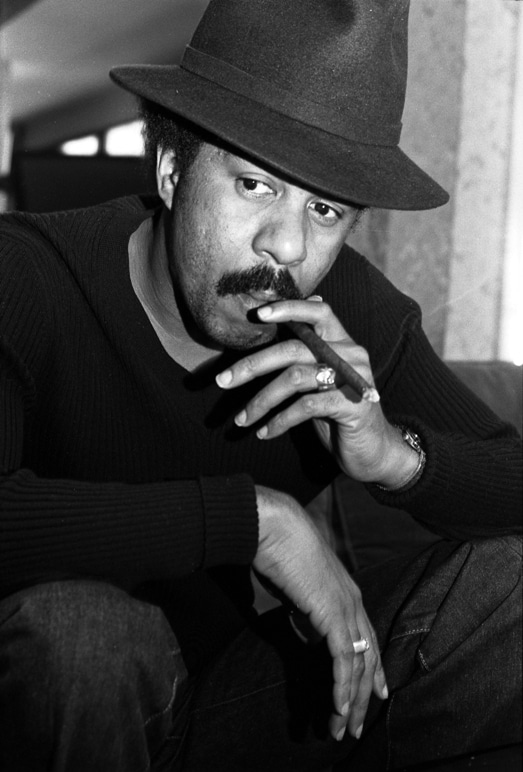
Richard Pryor in 1976. Photo by Marianna Diamos, from the Los Angeles Times Photographic Collection at the University of California, Los Angeles. Used under the Creative Commons Attribution 4.0 International license.
For a certain Gig Harbor Now columnist and several million other people, the names Richard Pryor and George Carlin were the gold standard of standup comedy in the 1960s and ’70s. By the 1980s, both had become legends, and still are today.
Yes, Richard Pryor worked on a Gig Harbor fishing boat. The boat wasn’t fishing at the time, so he was not a fisherman, which is why the setup to the questions specifically stated, “one or both of the answers we’re looking for may or may not have been a fisherman or fisherwoman. Mechanics, boat builders, electricians, painters, and other professionals worked on commercial fishing boats in Gig Harbor too.”
Movie makers are among “other professionals.”
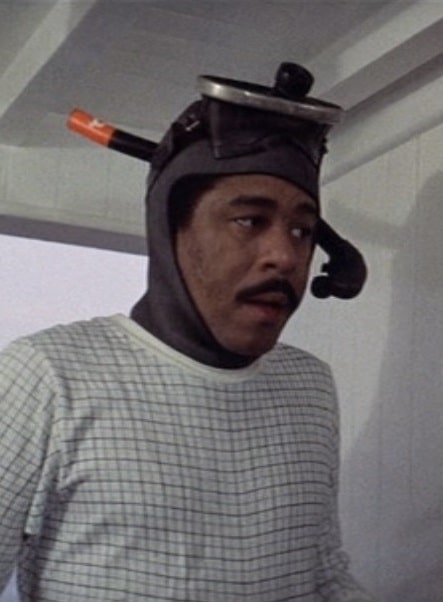
Richard Pryor is the best-known person to ever work on a Gig Harbor commercial fishing boat. Here, he’s inside the pilot house of Don Gilich’s boat, Victory, pretending to be ready to effect repairs below the water line. “Hit!” DVD copyright 2012 by Paramount Pictures.
In December 1972, Richard Pryor was working on Don Gilich’s fishing boat Victory, filming scenes for a movie with another pretty famous name, Billy Dee Williams. In fact, Billy Dee got first billing, with Richard second. But in spite of Billy Dee’s later successes (he was, after all, Lando Calrissian in the Star Wars franchise), he was not as famous as Richard Pryor at the time, nor is he now. Perhaps, sometime in the distant future, Billy Dee may eventually surpass … no, he won’t. That’ll never happen. It’s just not possible. Richard Pryor will forever get top billing in history’s memory. Considering statements like this, from his Wikipedia entry, “he is widely regarded as one of the greatest and most influential stand-up comedians of all time,” his place in history is assured.
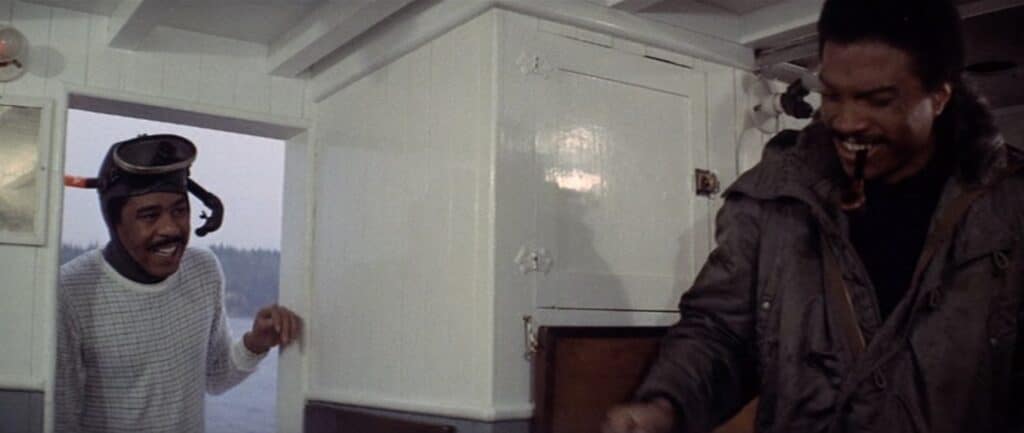
Richard Pryor, left, and Billy Dee Williams on the Gig Harbor fishing boat, Victory. “Hit!” DVD copyright 2012 by Paramount Pictures.
To be fair to Billy Dee Williams, it’s probably accurate to say that he was the second most-famous person to ever work on a commercial fishing boat in Gig Harbor.
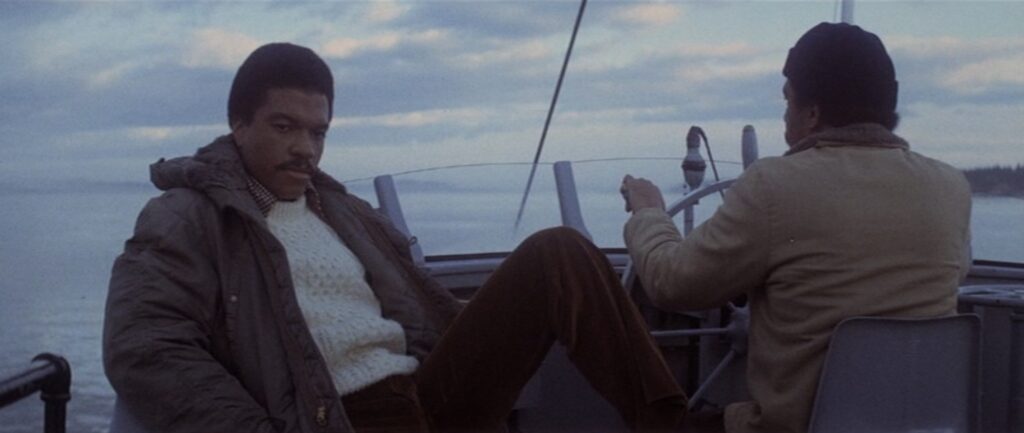
As Richard Pryor takes the Victory out of Gig Harbor, Billy Dee Williams, left, quietly contemplates the carnage he has planned for the bad guys. “Hit!” DVD copyright 2012 by Paramount Pictures.
Hollywood of the Pacific Northwest
The movie, which brought both men to Gig Harbor to film scenes on one of the fleet’s best remembered fishing boats, was titled “Hit!,” including the exclamation point. A more descriptive title would be “Thud!,” or maybe “Snooze!,” as it’s not such a great movie.
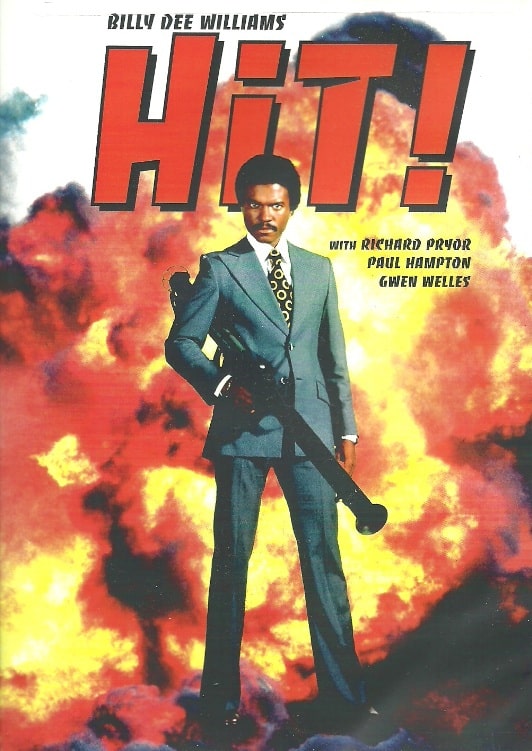
“Hit!” DVD copyright 2012 by Paramount Pictures.
Richard and Billy Dee give fine performances, just as they always did, but the script is pretty dumb, and more than just a little boring. To encapsulate the story in a single sentence, our two heroes lead a small group of others on a fishing boat from the Pacific Northwest to France to wipe out an illicit drug ring.
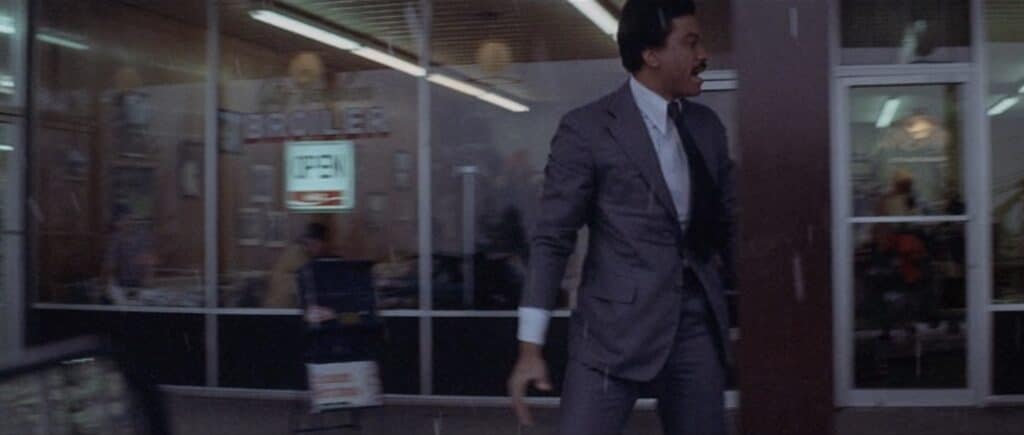
Billy Dee Williams filming a scene in front of Ralph and Marian Tachell’s Gig Harbor Broiler in the Peninsula Shopping Center in December 1972. “Hit!” DVD copyright 2012 by Paramount Pictures.
The very first question that synopsis raises is: couldn’t they find a boat just a little bit closer to France than on the west coast of the United States?
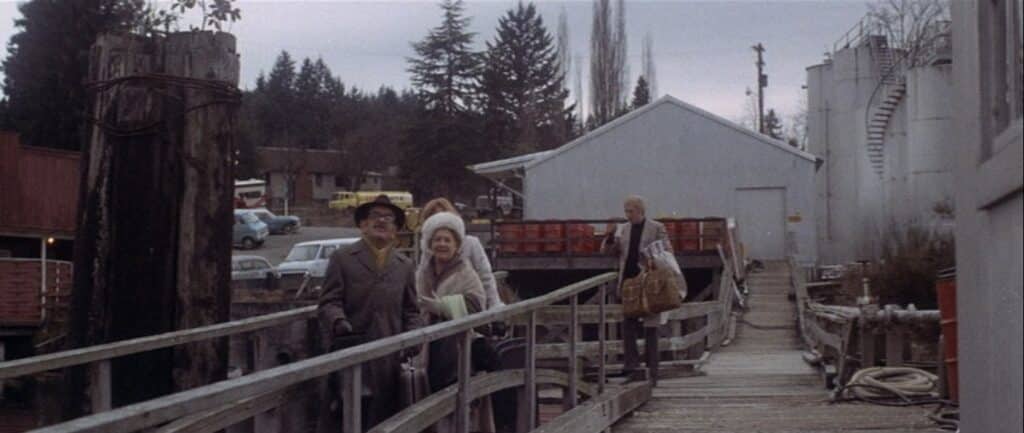
This is the other two thirds of Billy Dee’s hit squad, led by Alf Monroe from Hooterville. They’re heading down the gangplank at the Stutz dock to board the fishing boat Victory. “Hit!” DVD copyright 2012 by Paramount Pictures.
There are only three reasons to watch “Hit!” — Richard Pryor, Billy Dee Williams, and the scenes filmed in Gig Harbor in 1972. It would be too easy to joke that a fourth reason would be to help you fall asleep, but Richard and Billy Dee are always watchable, no matter what movie they’re in, so you’re not any more likely to fall asleep watching “Hit!” than you would be with any other movie with a ridiculous script. Although at a very long two hours and fourteen minutes, it certainly gives you more opportunities to drift off than a shorter film.
Illustrations cost money
Including some really interesting 1972 Gig Harbor images with this column almost didn’t happen. It’s an easy enough thing to take a few screenshots of Richard Pryor and Billy Dee Williams in Gig Harbor from a DVD of “Hit!,” but I didn’t happen to have one. Yes, you can get one on Amazon.com for less than twenty bucks, but I’m perpetually over budget on the Gig Harbor Now and Then expense account. Having never been funded, the account balance has yet to rise above zero.
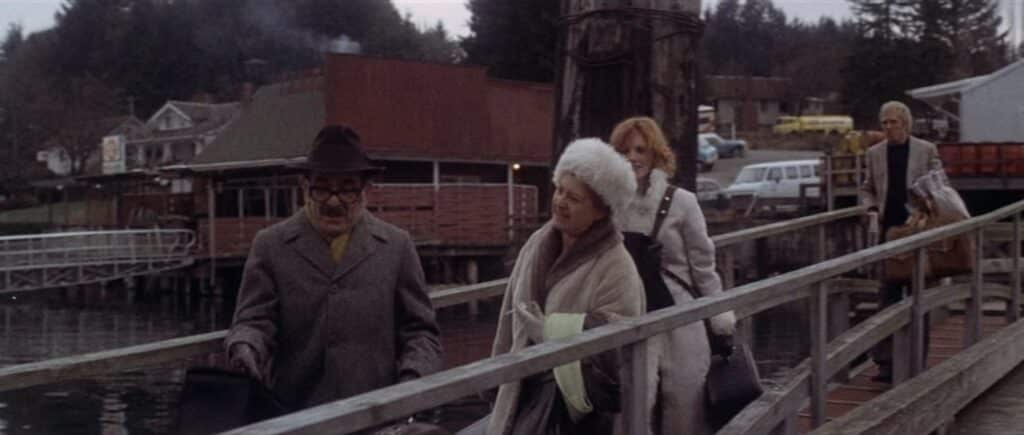
Another look at the rest of Billy Dee’s hit squad. Yes, that’s today’s Tides Tavern behind Alf Monroe. “Hit!” DVD copyright 2012 by Paramount Pictures.
Since the inception of this column I’ve been reaching into my own pocket for expense money, and on average it costs me right around a dollar per month. Sure, one dollar may sound like small potatoes, but there’s more than one month in a typical year, you know. Several, in fact.

The Gig Harbor fishing boat Victory leaving Gig Harbor for France, where a few drug kingpins would meet their maker. “Hit!” DVD copyright 2012 by Paramount Pictures.
Despite being over budget, I managed to get the screenshots anyway. Linda McCowen offered up ten bucks for the DVD, so I paid the balance. It’s through her generous offer that this week’s column comes complete with illustrations. And the fact that her house is in the background of some of the Gig Harbor scenes played no role in her magnanimous gesture, I’m sure.
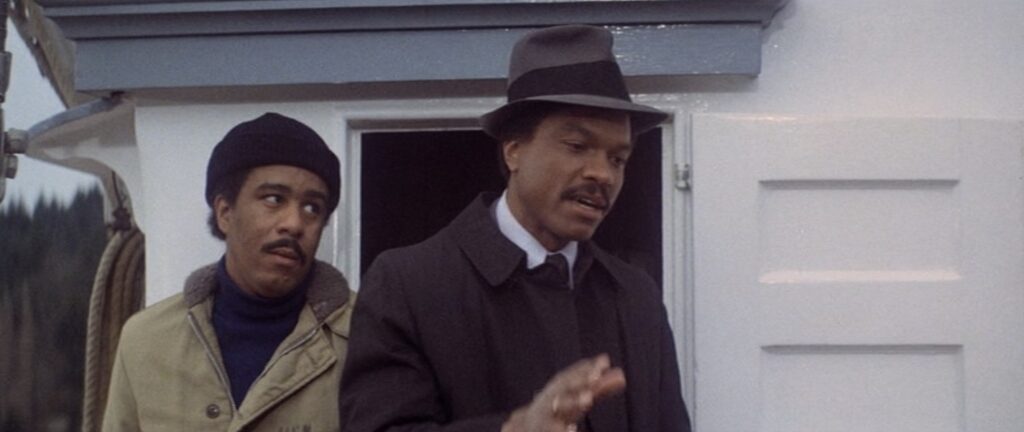
Richard Pryor, left, and, Billy Dee Williams are the two best known people to ever work on a Gig Harbor commercial fishing boat. “Hit!” DVD copyright 2012 by Paramount Pictures.
There is one more thing about “Hit!” that’s a distraction. Because Richard Pryor and Billy Dee Williams were always so good in everything they ever did, if you watch the movie you’ll probably be constantly wondering how such charismatic actors ended up in such a clunky movie.
Maybe because they couldn’t tell how it was going to turn out?
A Gig Harbor movie, but no Gig Harbor theater
After the excitement of a big-budget Hollywood movie filming in Gig Harbor, it was unfortunate that it had been 15 years since the town’s only movie theater had closed. To see “Hit!,” Peninsula moviegoers had to cross the Narrows Bridge. When it came to Tacoma in late 1973, a group of seniors from Peninsula High School saw it at the Proctor Theatre in North Tacoma. While the Gig Harbor scenes were interesting to watch, I don’t recall any of us claiming to have seen a good movie.
Only one line of dialog has stayed in my memory all these years. While I can’t recite the exact words, the meaning is still clear. Richard Pryor was the master mechanic in charge of getting the Victory in shape to sail to France (still a dumb notion). He comes up out of the bilge after inspecting the boat, and Billy Dee Williams asks him what he thinks of its condition. Richard looks at him and says, “It’ll take me a year and a half to get it ready to sink!”
I wonder what Don Gilich thought of that line?
A matter of age
Am I the only one who remembers Richard Pryor’s Rumpelstiltskin routine from the 60s? “My name is Rumpelstiltskin and I’m a meanie!”
Next time
In two weeks we will have a few Now and Then comparisons of Gig Harbor photographs, Now being 2025, and Then being 1972. Any guesses as to where the 1972 shots came from?
— Greg Spadoni, June 2, 2025
Greg Spadoni of Olalla has had more access to local history than most life-long residents. During 25 years in road construction working for the Spadoni Brothers, his first cousins, twice removed, he traveled to every corner of the Gig Harbor and Key Peninsulas, taking note of many abandoned buildings, overgrown farms, and roads that no longer had a destination. Through his current association with the Harbor History Museum in Gig Harbor as the unofficial Chief (and only) Assistant to Linda McCowen, the Museum’s primary photo archive volunteer, he regularly studies the area’s largest collection of visual history. Combined with the print history available at the museum and online, he has uncovered countless stories of long-forgotten local people and events.

